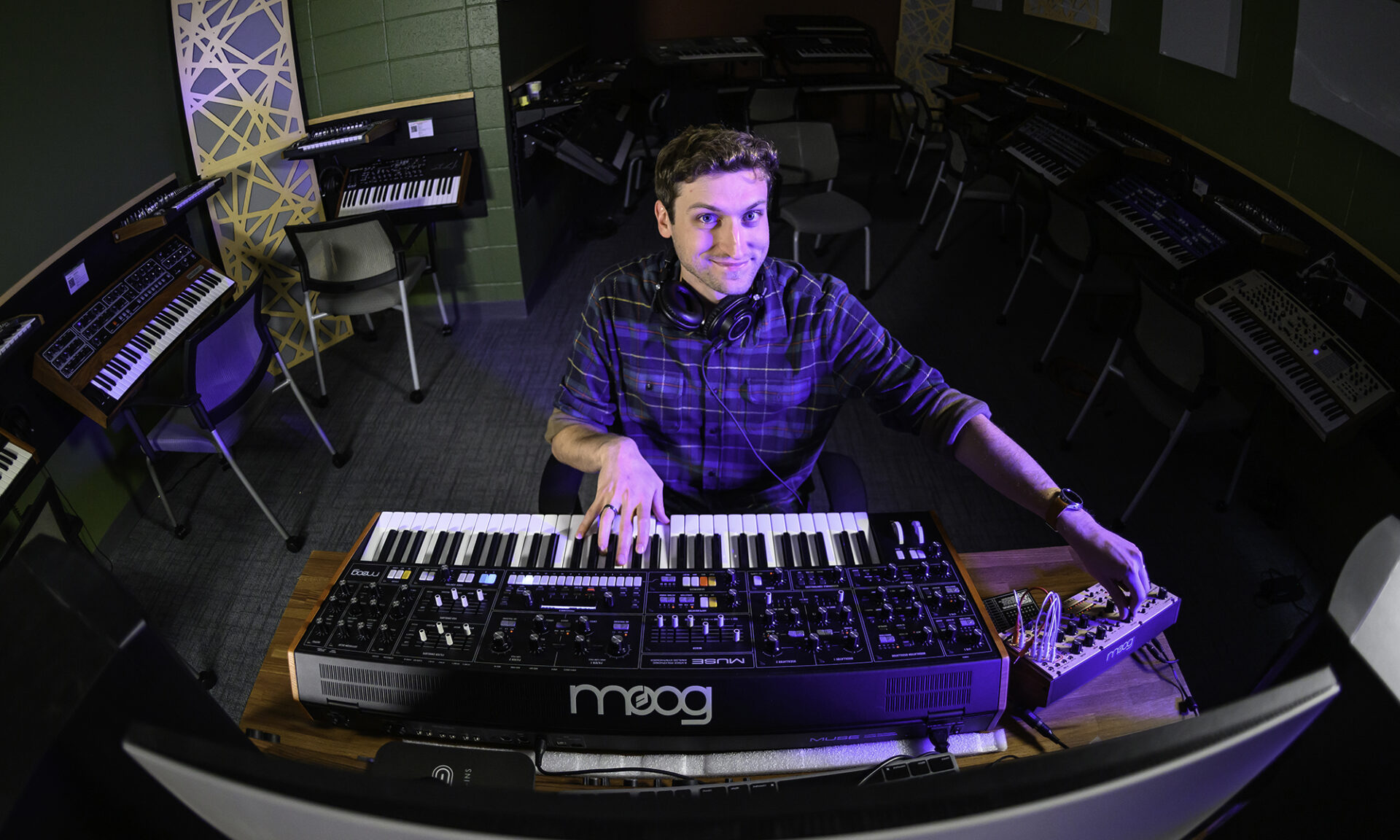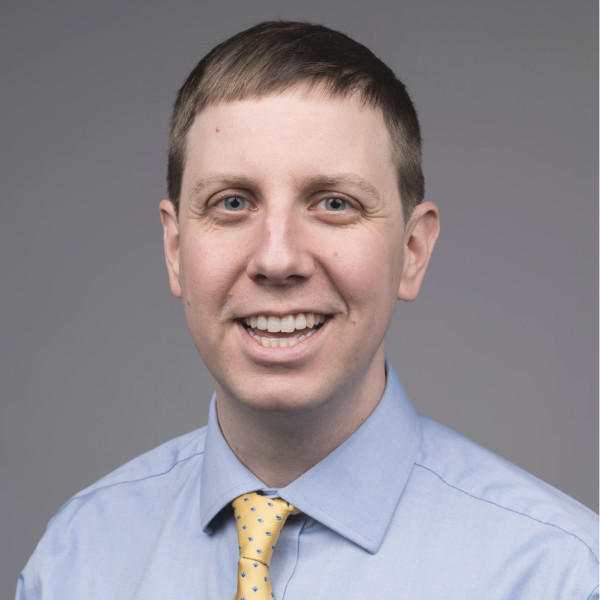Rick Carl ’19, ’20 (MS): Blending creativity and engineering in synthesizer design

The synthesizers Carl created for Moog Music Inc., including the Labyrinth and Muse, are part of a new cutting-edge lab at URochester.
Designing synthesizers for musicians is a delicate balance of art and engineering according to Rick Carl ’19 (audio and music engineering), ’20 (MS, electrical and computer engineering).
A hardware engineer at Moog Music Inc., Carl is deeply involved in the product design for new instruments. Taking inspiration from the storied company’s founder Robert Moog, Carl handles everything from architecting systems to designing circuits, writing code, and debugging prototypes. Frequently collaborating with musicians in Asheville, North Carolina; Nashville; and Los Angeles, his designs walk a fine line between paying homage to Moog’s roots while advancing technology in interesting new directions.
Striking that balance has earned Carl’s designs—including the Moog Labyrinth and the Moog Muse synthesizers—critical acclaim. He credits the education he received at the University of Rochester with preparing both the left and right sides of his brain for the challenge of synth design.
“Electrical engineers often fall in the trap of trying to create synthesizers by designing perfect circuits that perform optimally and tick every single metric but end up sounding boring,” says Carl. “You have to be open and have an ear to bend the rules to get something that sounds nice. Rochester’s AME program gave me the tools to develop that ear without skimping on the hard skills.”
Synthesizing a career out of passion
When Carl was in middle school in Knoxville, Tennessee, his garage band was searching for a “sound.” He picked up a synthesizer and quickly fell in love.
Growing up about two hours from Moog Music’s factory in Asheville, he made the pilgrimage there several times throughout high school and knew it was the place he wanted to work someday. He found out about URochester’s audio music and engineering (AME) degree program and saw a path to his dream job.
“The AME program was tailor made to exactly what I wanted to do,” says Carl. “The really valuable thing to me about it was the balancing of the creative and subjective side with the hard skills in circuit design, digital signal processing, and all of that, because both sides are equally important.”
While he was a student at URochester, he cold called the receptionists at Moog Music several times about internship opportunities and was initially rebuffed. But his persistence paid off, and he interned there in 2019, affirming that it was the place he knew he belonged.
Carl returned to his studies after his internship with a foot in the door and a refined focus on what he had yet to learn. Carl had entered URochester on an accelerated path to earn his master’s degree in five years through the Graduate Engineering at Rochester (GEAR) program and says the fifth year provided him crucial skills for his career.
“It gave me context for some of the problems I run into now as I’m learning how to design higher and higher speed boards,” says Carl. “All of the converter knowledge I got from that fifth year plugged perfectly in with the research I ended up doing here at Moog. When I got here, I told them ‘I learned all this stuff in grad school and I can probably design a way that we can do this cheaper and better,’ and they said, ‘let’s do it.’”

Career at Moog Music
Carl has been heavily involved with internal research at Moog Music since joining the company in November 2020. One of his earliest projects was a Eurorack case for housing modular synths.
“It was not very glamorous, but it taught me quite a bit about power supply design because it had to be able to power anything you throw at it and tolerate some pretty poor circuit designs,” says Carl. “In the modular space you have everyone from actual electrical engineers to amateur hobbyists using them, so it had to be very resilient and clean.”
He led research efforts before he got his first chance to spearhead a major project he called the Labyrinth, released in July 2024. As the system architect and lead hardware engineer, he set out to create a drum synthesizer with generative aspects, meaning it will create rhythms and melodies using random chance.
“We ended up designing something that gives people a very different sound from a traditional Moog synthesizer while still maintaining the quality that everyone associates with Moog,” says Carl. “We created a new and fun sequencer interface for generating melodies and rhythms that can be driven by random chance but are still very much controlled. You can set up a starting place and explore from there, hence the name ‘Labyrinth’ because you can go in so many different directions.”
Musician and YouTube personality Andrew Huang called it Moog’s “best release in years” and used it to create a 2024 collaborative album with fellow artist Undulae titled Labyrinth.
“This is my favorite instrument to come out in ages because it just constantly gives you these delightful surprises,” says Huang. “You have to always be recording when you’re using it because you’re able to transform the sounds and sequences so quickly, you can never fully predict where you’re going to end up with it even though you can steer it in a lot of ways. It’s really genius.”
Carl also wrote code and did the circuit design for the Moog Muse, the company’s new flagship polyphonic synthesizer released in 2024. Music Radar called it “The purest, most characterful poly that Moog has made in recent memory.”
Carl has many more designs in the pipeline, and now his creations will help to train the next generation of AME students at URochester. The AME program’s faculty, including Distinguished Professor Mark Bocko and Distinguished Lecturer Robert LaVaque, made sure to include the Labyrinth and Muse in a state-of-the-art synthesizer lab in the Computer Studies Building. The lab features more than 50 synthesizers and enabled the department to offer a new course in synths, samplers, and drum machines. Carl was invited for the lab’s grand opening and to speak to students in the new class in October.
“It was an honor having Rick back on campus to provide our students with a master class on these instruments,” says LaVaque. “He serves as an inspiration for students in our AME and audio arts and technology program.”

A bonus Rochester connection
Robert Moog and Herbert Deutsch co-invented the first commercial synthesizer in 1964. The electronic music pioneers first met in November 1963 at a NY State School Music Association Allstate conference at the University of Rochester’s Eastman School Music. Moog was selling theremins—electronic musical instruments played without touching them—and Deutsch invited him to an electronic music concert. Together they would design the groundbreaking synthesizer the Moog, which would be used by some of the biggest rock and pop acts of the late 1960s—including the Doors, the Byrds, and the Beatles—and become a staple of progressive rock in the 1970s.
Robert Moog next to his eponymous synthesizer in the 1970s. (Photo courtesy of Wikimedia Commons)




